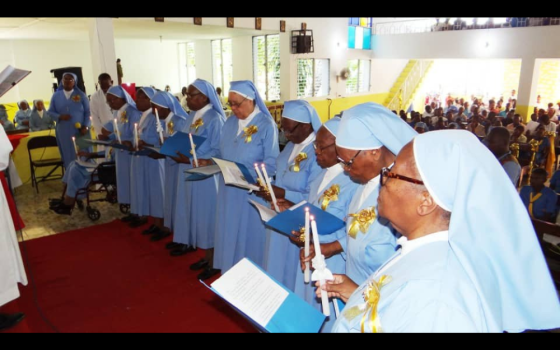
American women religious say they are cautiously optimistic that the two-year study of their life, ordered by the Vatican late last month, will give a truthful picture of their dedication and service to God, the church and the world, and that it will promote greater understanding of the lives of religious women in the United States.
But they are also expressing concern about not being consulted in the process, about the way in which it will be handled and about the confidentiality of the visitation reports.
Meanwhile, a U.S. women religious group Feb. 12th called the study “confusing, questionable, and biased.”
“The Vatican's expressed concern about the ‘quality of life’ of women's communities causes us to wonder why they are not equally concerned about communities of men religious. This double standard puzzles and perplexes us,” read the statement by the National Coalition of American Nuns.
Other sisters were asking: Why try to solve a problem that doesn’t exist?
“My response is difficult because we’ve had no direct communication” about the study, said Sr. Mary Ann Zollmann, president of the Blessed Virgin Mary (BVM) sisters of Dubuque, Iowa. Zollmann said that other than two messages from the Leadership Conference of Women Religious, of which she is a past president, “my only information has come from the media. … It has a different feel about it when you hear about it in the media. It remains quite tentative,” she told NCR in a telephone interview Feb. 10.
----------------------------------------------------------------------------------------------------------------------------------------------------------------
'Next time, Let's have the Women study the Men:' A Commentary by NCR Editor Tom Fox
----------------------------------------------------------------------------------------------------------------------------------------------------------------
Zollmann said the BVMs, who comprise 556 sisters in the United States, Ecuador, Guatemala and Ghana, “have a wonderful story to tell of how our sisters have responded to the church’s invitation at Vatican II.”
She thought each congregation needed to “respond faithfully out of its own integrity” to the visitation process.
The BVMs are in a leadership team with Presentation, Franciscan, Dominican and Humility sisters in the Dubuque area. “Our approach [to the study] will be one of being connected” to these sister communities, she said.
Zollmann said it was “most important” to guarantee the confidentiality of each visit. It was her hope that the reports coming from the visits of Mother Mary Clare Millea and Sr. Eva-Maria Ackerman be shared and discussed among the sisters so that “we can all deepen our understanding” of religious life as it is lived in the United States.
In Newton, Mass., Sr. Suzanne Fondini, who heads the Missionary Franciscans of the Immaculate Conception, told NCR that her nuns look forward to Mother Clare’s visit so that sisters, associates and coworkers can share “the good works done in spreading the Gospel message, as well as living our evangelical call in our 21st-century world. The Franciscans are based in the United States and in Peru, Britain, Ireland, Papua New Guinea and Australia.
Sinsinawa Dominican Sr. Donna Quinn of Chicago wants the National Coalition of American Nuns, of which she is a cofounder and officer, to launch a women’s summit in response to the Vatican’s call for an apostolic visitation of congregations.
“This summit would share our lived experience as women,” she told NCR. It would also call for the ending of gender discrimination, which Quinn called the most deeply rooted, destructive and violent of all “isms” in organized religions and the world today.
She urged Rome to end “its continued educating, promoting and perpetuating this violence.” Before reviewing “our lived experience as nuns,” Quinn thought the Vatican ought first to apologize “for its complicity in refusing to build a church for our daughters and sons,” one that is devoid of sexism and uses inclusive language in its sacraments, liturgy and teaching, she said.
Most “grass-roots sisters” who have talked to Margaret Thompson since the Vatican study was disclosed in a Washington press conference Jan. 30 are “concerned, even disgusted, that the Leadership Conference of Women Religious was ignored and kept out of the loop” by the surprise announcement. “Most sisters are used to being involved in a process … and to a certain amount of transparency,” she told NCR.
Thompson, a professor of history and women’s studies at Syracuse University in New York, is the author of Nuns: A Vanishing Species in the Catholic Church? and is also an associate of the Monroe, Mich., Immaculate Heart of Mary community.
The professor thought Rome’s review order had arisen from a “quantitative, rather than a qualitative evaluation” of U.S. nuns. It is evident that nuns are graying and not growing, with some 120,000 fewer U.S. sisters today than at the end of Vatican II.
She pointed to the Vatican’s recent investigation of U.S. Catholic seminaries, which she said was prompted by the pedophilia crisis. “What is the comparable problem that has impelled this study?” she asked, noting, “Why is the Vatican trying to solve a problem that doesn’t exist?
Thompson, who said she was speaking for herself and not representing the views of any sisters or congregation, wondered why Millea and Ackerman were picked to run the visitation process. “We haven’t seen their credentials.
“I would have thought we could have assembled a committee of experts from among the many sisters who have demonstrated real scholarship in theology and sociology,” she said.
Neither Millea nor Ackerman comes from a large congregation. Both “bring the vision of a traditional community,” Thompson said, adding that such a vision is welcomed. However, she wondered if the Vatican meant to imply that such orders were to become “normative” for consecrated life.
“I hope I’m wrong, but I don’t think this is anything but a very reactionary attempt on the part of the hierarchy to impose its own solutions to problems they have been thinking about for decades.”
With the average age of American nuns being above 70, retired sisters are reserving their responses to the Vatican's Apostolic Visitation until more information is received - either directly to their leaders from Mother Mary Claire or through the LCWR, according to one sister who is in touch with several others through e-mail and daily living. Dominican Sr. Adrian Hofstetter, 89, who lives with some 50 sisters in the assisted living Motherhouse in St. Catherine, Ken., is still active in peace work and in helping sisters in the care center. The nuns share small resident communities of seven members and eat their meals together.
Conversation about the proposed Sister Visitation is ongoing with several of the sisters expressing hope that it will be worthwhile, but not an attempt to reverse changes in religious life that have occurred since the close of Vatican II, Hofstetter told NCR.
She thought a focus on the mission activities of religious orders "could be beneficial." Hofstetter said the four-to-five-year reconfiguration of the Kentucky community will end in April when the 200 sisters merge with six other Dominican congregations to become the Dominican Sisters of Peace. The new body will comprise 800 sisters and 500 aassociates. "We are intent on discovering the mission or missions we are being called to at this time," Hofstetter said.
Patricia Lefevere is a frequent NCR contributor.


